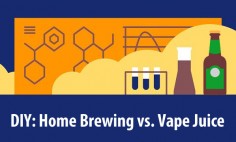Parents of teenagers have a hundred things to worry about on a regular basis. From ensuring your child is staying healthy and developing adequately in all aspects, to giving them their space and respecting their privacy, there are a lot of things to focus on.
But amidst all this, there are a lot of scary things that can happen, the scariest of which for many parents is addiction.
Harmful levels of substance use is becoming increasingly common among kids and teens, especially because of easily accessible substances like nicotine, alcohol, or certain types of drugs.
Of the most common forms of substance abuse these days is vaping, which is practiced using e-cigarettes.
If you discover your child is vaping, there are fortunately steps you can take to help them understand the consequences of their choices and guide them toward a better, healthier path. Let’s take a closer look.
To know more about what vaping is and why it is so popular, visit here. For more resources on parenting a teenage child, especially in relation to addiction, click here.

What exactly is vaping?
Vaping, sometimes known as “JUULing,” involves the use of e-cigarettes, vape pens, or vaporizers, which are easy-to-use, concealable, and generally do not leave any strong odor behind.
These devices are rechargeable and contain cartridges filled with a liquid that contains nicotine and flavorings.
This nicotine liquid, when heated in these devices produces smoke, which is inhaled and exhaled. This process is called vaping.
In recent years, vaping has gained extreme popularity with teenagers and young adults, in part due to multiple advertising strategies. It was initially marketed as a safer alternative to normal cigarettes, and a means to quit smoking.
3 Risks Associated with Vaping for Teens
Why exactly is vaping bad if it is a safer alternative to smoking?
Although we do not have enough research evidence to know all the medical consequences of vaping since it is such a recent trend, there are plenty of reasons why it is harmful, especially for teenagers.
- Addiction: Addiction is the number one risk factor associated with vaping. Although the devices used for vaping contain a lower amount of nicotine – an amount which is indeed needed to quit a nicotine addiction – they still do contain nicotine in high amounts, which means people who use them can still get addicted. A nicotine addiction is very hard to overcome. To make things even more concerning, these devices also contain other harmful chemicals than nicotine.
- Brain development: Teenagers who vape risk serious harm to their brain development, primarily because their brains and bodies are still in the developmental phases at that point in their lives. A nicotine addiction can impair their ability to focus, to remember, to stay attentive and alert.
- Lung damage: The long-term effects of vaping are still unknown to us at this point, but just as with smoking, vaping does damage the lungs. It is a myth that vaping does not hurt your lungs, but this misunderstanding is commonly perpetuated by teens because vaping is considered to be the safer alternative to smoking.
How Teenagers Can Overcome Vaping Addiction
Battling addiction is a difficult and long process, but dividing it into steps to form a comprehensive plan will prove helpful in the long run.
Here are some things to consider:
- Peer pressure: The influence of peers on teenagers should never be underestimated, especially when it comes to addiction and substance abuse. If your child’s friends and social circles are involved with vaping, it might be a good idea to consider shifting your child away from these groups, at least for a while. But also remember, do not isolate your child entirely, and ensure they have a good support system at all times. This support system should include more people apart from just your family.
- Encourage open conversations: Talk to your child openly about the dangers of vaping, and your concerns regarding the same. Privacy is very important for teenagers, so do not push them to talk to you more than they want to. However, it is important to let your teenager know that you are there for them, and are willing to help at all times.
- Define objectives: The first step to achieving any goal is to understand your motivations behind that goal. Identify why it is important for your child to quit vaping. Ask them to make a list of aims and motivations, and put this list in close proximity to them so that they can revisit the list regularly.
- Commit to the goal: Encourage your teen to announce to everybody possible that they are quitting vaping. This way, they will be more accountable to more people, and feel an increased sense of responsibility about quitting vaping. Prepare realistically for withdrawals and relapses, but arrange for more accountability and a stronger commitment to the goal.
Final Thoughts
Vaping, at the end of the day, is another concern that parents of teens can add to an ever-growing list.
Though vaping should be taken seriously, it’s relatively simple to understand why your teen may feel the urge to vape and, as a result, approachable to work with them to find an alternative solution.
Redirecting the urge to vape toward something healthier, like a hobby or sport, in addition to mindfulness, communicating the reality of nicotine addiction, and even the guidance of a mental health professional can all go a long way.
Through these techniques, it’s possible to treat your teen like the evolving, young-adult they are while still prioritizing their safety.















